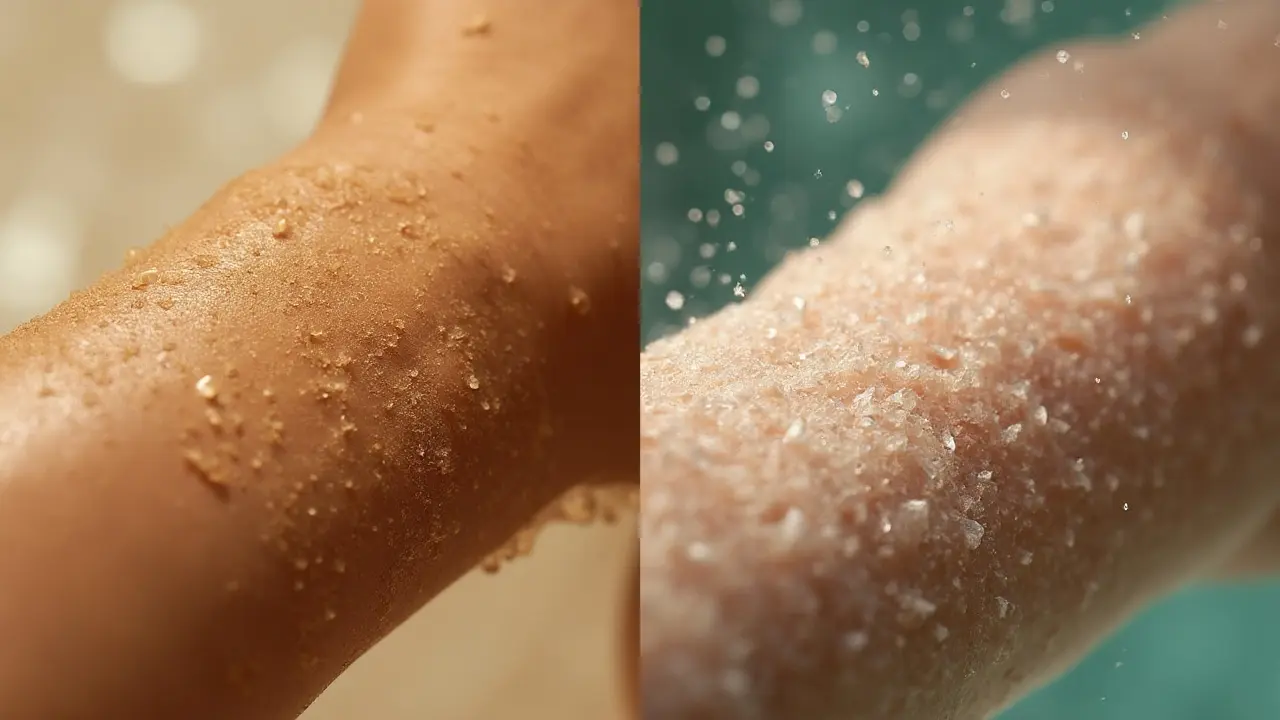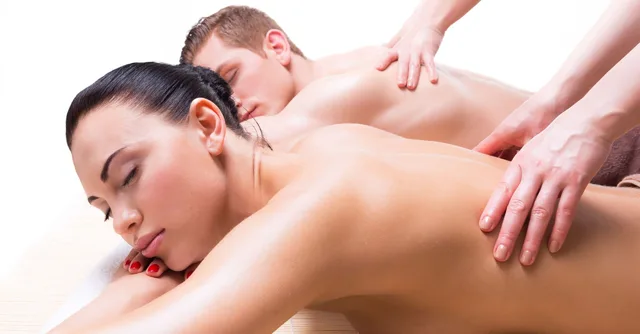Ever finish a shower and think, “Was that scrub even doing anything?” Or try dry brushing and wonder if you’re just scratching yourself? The short answer: both wet and dry methods work-just not for the same skin, the same day, or the same goal. I live in Dubai, where heat, sand, and SPF build-up are real, and between school runs with my daughter and a cat who thinks my loofah is prey, I’ve tested every way to exfoliate without wrecking my skin barrier. Here’s the straight talk you actually need.
TL;DR: Wet or Dry-Which Scrub Method Wins?
Here’s the short version of wet vs dry scrubbing:
- Face: always damp/wet. Use chemical exfoliants (AHA/BHA/PHAs) or very fine, gentle scrubs. Never dry scrub facial skin.
- Body: dry brushing works before you shower if your skin isn’t reactive; it boosts circulation feel and helps with flaky shins and ingrowns. Wet scrubs are best for most people because water softens skin and lowers irritation.
- Sensitive, eczema-prone, or post-retinoid? Go wet and gentle-or skip physical scrubs and use mild PHAs. Dry scrubbing can be too abrasive.
- Want glow and smoother texture fast? Wet scrubs or rinse-off acids in the shower. Want a pre-shower polish and lymphatic-style brushing feel? Dry brushing.
- Dermatology guidance (e.g., American Academy of Dermatology) backs gentle pressure, fewer sessions per week, and avoiding combo-exfoliating (like scrubs plus acids plus retinoids in one night).
How to Scrub on Wet vs Dry Skin (Face & Body): Exact Steps
You clicked for a clear answer, but you also want the “do this, not that” playbook. Here’s how to get smooth, not sensitized.
First, pick your lane:
- Choose dry brushing if your skin is normal-to-oily on the body, not very sensitive, and you like a quick pre-shower routine.
- Choose a wet scrub (sugar/salt or rice/oat/jojoba beads) if you want gentler friction and that post-shower softness.
- Choose a chemical exfoliant (AHA/BHA/PHAs) if you have acne, keratosis pilaris, or uneven tone and want even coverage with minimal rubbing.
Pressure rule that saves skin: if you see redness that lasts more than a few minutes or it stings in the shower, you’re overdoing it. Scrubbing should feel like a soft T-shirt glide, not sandpaper.
Dry Brushing: Body Only (Pre-Shower)
- Start completely dry. Skin and brush should be dry. Use a natural-bristle brush with a gentle give (avoid super stiff bristles).
- Brush in short, light strokes toward the heart: feet to knees, knees to thighs, hands to shoulders, small clockwise circles on the abdomen.
- Time: 2-5 minutes total. Stop sooner if you spot redness or feel scratchy heat.
- Shower to rinse off loosened flakes. Use a gentle cleanser; skip harsh soaps.
- Moisturize within 3 minutes of toweling off (look for ceramides, glycerin, urea 5-10%).
Best for: flaky legs, keratosis pilaris on arms, ingrown-prone bikini/underarms (avoid broken skin). Not for: eczema, psoriasis flares, sunburn, fresh tattoos, after waxing/laser.
Wet Scrub: Body (In-Shower)
- Soak skin 1-2 minutes in warm water to soften the outer layer. This reduces friction and micro-tears.
- Turn off or step away from direct stream so scrub doesn’t rinse off instantly.
- Apply a small amount of scrub to damp skin. Sugar is gentler than salt; look for rounded particles or beads made from jojoba/biodegradable cellulose.
- Massage in small circles for up to 30 seconds per area. Use your fingertips, not your whole palm weight. Skip thin-skinned zones like the chest if you’re sensitive.
- Rinse well, then pat dry. Seal with moisturizer and SPF if it’s daytime.
Pro tips:
- Shave after a wet scrub if your skin tolerates it-less drag, closer shave. If you’re prone to razor burn, scrub the day before instead.
- Self-tan routine? Exfoliate wet the day before you tan for the most even color.
- Dubai note: hard water + heat can dehydrate. Keep showers short and lukewarm, and use fragrance-free moisturizers.
Wet Exfoliation: Face
- Cleanse first. Leave the face slightly damp.
- Pick the formula:
- AHAs (glycolic, lactic) for dullness/textural bumps.
- BHAs (salicylic) for blackheads and oil-prone areas.
- PHAs (gluconolactone, lactobionic) for sensitive or barrier-compromised skin.
- Use fingertips or a soft cotton pad. No rubbing pads back and forth; glide once.
- Frequency: start 1-2x weekly. Sensitive skin? Try PHAs first.
- Moisturize and use SPF 50 in the morning. Acids make skin more sun-sensitive.
What science and derms agree on (summarized): the AAD and UK dermatology bodies advise gentle pressure, lower frequency for sensitive skin, and avoiding stacking multiple exfoliants the same day. For many, chemical exfoliation is more controlled and less damaging than harsh scrubs. You don’t need redness to “prove” it worked.
How often should you exfoliate?
- Dry brushing body: 2-3x/week max.
- Wet body scrub: 1-2x/week (legs can often handle 2-3x, chest maybe 0-1x).
- Face acids: start 1-2x/week; some can build to 3x if barrier is happy.
Don’ts that save you from irritation: right after laser, waxing, or strong retinoids; on sunburn; on open cuts or active eczema; with pumice-level grit; or pressing hard to “speed things up.”

Compare Methods + A Simple Decision Guide
If you like quick visuals, this is your section. Use the table and the checklist to pick a method today, and a different one next week if your skin changes. That’s normal.
| Factor | Dry Brushing (Body) | Wet Scrub (Body) | Wet Chemical Exfoliation (Face/Body) |
|---|---|---|---|
| Best for | Flaky legs, KP bumps, circulation “boost” feel | General smoothing, pre-shave polish | Acne, blackheads, uneven tone/texture |
| Skin types | Normal to oilier; not reactive | Most skin types if gentle | All, with formula choice (PHAs for sensitive) |
| Irritation risk | Medium if overdone | Low-medium (lower if particles are soft/rounded) | Low-medium (depends on % and frequency) |
| Use on face? | No | Very rarely, only ultra-fine beads; not ideal | Yes (AHA/BHA/PHA as directed) |
| Frequency | 2-3x/week | 1-2x/week | 1-3x/week (start low) |
| Best timing | Before shower | Mid-shower after a short soak | At night (face) or in-shower rinse-off for body |
| Skip if | Eczema/psoriasis flare, sunburn, post-wax/laser | Open cuts, sunburn, post-wax/laser | Retinoid night, broken barrier, immediately post-procedure |
| Aftercare | Moisturize within 3 minutes | Moisturize within 3 minutes | Moisturize; daily SPF 50 |
Quick decision checklist (today):
- If your skin feels tight, itchy, or you’ve used retinoids last night → choose a gentle wet routine or skip today.
- If you see flakes on shins/arms and your skin is not reactive → dry brush for 2-3 minutes, then shower and moisturize.
- If you want a closer shave tonight → do a quick wet scrub first, then shave with lots of slip.
- If you’re breaking out or fighting blackheads → use salicylic acid (BHA) on damp skin, hands only, no scrubbing pad.
- If your chest and neck get red easily → avoid physical scrubs there; try PHAs once weekly.
Product pairing rules of thumb:
- Do not stack: scrub + acid + retinoid the same night. Pick one.
- Skip perfume-heavy body lotions after scrubbing; choose barrier-focused formulas (ceramides, squalane, shea, urea).
- If you live in hot, dry climates (hello, Gulf summers), add a hydrating layer first (hyaluronic/ glycerin), then a richer cream to seal.
How to tell you over-exfoliated: stingy cleanser, tightness after washing, patchy redness that lasts, makeup looks rough. Pause all exfoliants for 5-7 days, moisturize, and reintroduce slowly.
FAQ + Troubleshooting
Is it bad to scrub on dry skin?
Not bad by default, but it’s easier to overdo. Dry brushing is a specific technique with a soft brush and light pressure, not a handful of gritty scrub on dry skin. Granular scrubs on dry skin often cause micro-tears and hot redness-skip that.
Can I scrub before or after shaving?
Before usually works best. A quick wet scrub lifts dead cells and reduces tug. If your skin gets angry easily, exfoliate the day before instead. Always use a fresh blade and plenty of slip.
What if I have body acne?
Use salicylic acid (BHA) washes or leave-ons on wet skin, 2-3x a week to start. Physical scrubs can pop pustules and spread bacteria. Keep it gentle and consistent. Many derms prefer BHAs for back and chest acne for this reason.
How long after waxing/laser can I exfoliate?
Give it at least 48-72 hours after waxing and a full week after laser (or as your provider advises). Skin is more vulnerable; scrubbing too soon can cause burns and pigment issues.
I use a retinoid. Can I still exfoliate?
Yes, but alternate nights. Retinoids already speed up cell turnover. Stack them with acids or aggressive scrubs and you’ll likely peel and sting. If you’re new to retinoids, let your skin settle for a few weeks first.
Is a loofah the same as scrubbing?
Not really. Natural loofahs can be rough and trap bacteria. If you use one, disinfect and replace often. Silicone scrubbers are easier to keep clean and gentler.
What about cellulite-will scrubbing help?
Exfoliation can make skin look smoother briefly by removing flakes and boosting surface circulation feel, but it won’t restructure fat or connective tissue. Think of it as a polish, not a remodel.
Can I exfoliate during pregnancy?
Usually yes, but keep it gentle. Many OBs and derms suggest avoiding high-strength salicylic acid peels; low-strength washes or PHAs are commonly considered reasonable. Always check with your doctor.
Hard water is wrecking my glow. Any fix?
Try a quick final rinse with bottled or filtered water on face, then pat on a hydrating toner and seal with moisturizer. On the body, finish with a glycerin-rich lotion. Shorter showers help.
Do I need to feel a tingle for it to work?
No. Tingle or sting is not a sign of success. Smoothness over 24-48 hours and better product absorption are better signals.
What’s the safest order on a “spa night”?
Cleanse → wet exfoliate (or dry brush then shower) → rinse → hydrate serum → rich moisturizer → sleep. No retinoids or strong acids on the same night as scrubbing.
Quick troubleshooting by skin mood:
- Red and stingy today: skip exfoliation, layer a bland moisturizer, SPF in the morning.
- Flaky but sensitive: PHA toner on damp skin once this week; no scrubs.
- Ingrowns on bikini/underarms: salicylic 2% every other night; gentle wet polish only once weekly.
- Sunscreen build-up (hello beach days): oil cleanse first, then a gentle gel cleanser, then a mild AHA once or twice weekly.
Why many dermatologists prefer wet exfoliation for most people
Water softens the stratum corneum (the outer skin layer), so less force is needed. That means less microtrauma. Guidance from professional bodies like the American Academy of Dermatology and the British Association of Dermatologists consistently stresses gentle technique and smart frequency-both are easier to nail with wet methods or with controlled chemical formulas.
My personal cheat sheet (tested in Dubai heat):
On sweaty, sandy pool days with my kid, I oil cleanse body, do a 45-second sugar scrub on damp skin, rinse, then a ceramide cream. On calmer weeks, I dry brush legs for two minutes before quick showers. Face gets PHAs midweek and retinoid on a separate night. It’s boringly consistent-and it works.
Bottom line you can use today: If your skin is even a bit reactive, go wet and gentle. Reserve dry brushing for sturdy body skin and light pressure only. Face stays in the wet camp with acids or ultra-fine scrubs. Keep frequency low, moisturize after, and wear SPF. That’s how you get smooth, not sore.







September 7, 2025 AT 13:57
While the post covers a lot of ground, it’s worth emphasizing that the stratum corneum’s hydration level dictates the choice between wet and dry exfoliation. In a hyper‑humid environment like Dubai, water can actually exacerbate barrier disruption if not followed by a quick moisturiser. For facial skin, the literature consistently recommends a pH‑balanced, low‑abrasion scrub applied to damp skin; dry brushes should be strictly limited to the body. Also, the recommendation to avoid stacking acids with retinoids aligns with the American Academy of Dermatology’s guidelines. Lastly, any exfoliation routine should be adjusted seasonally to compensate for variations in indoor heating and air‑conditioning.